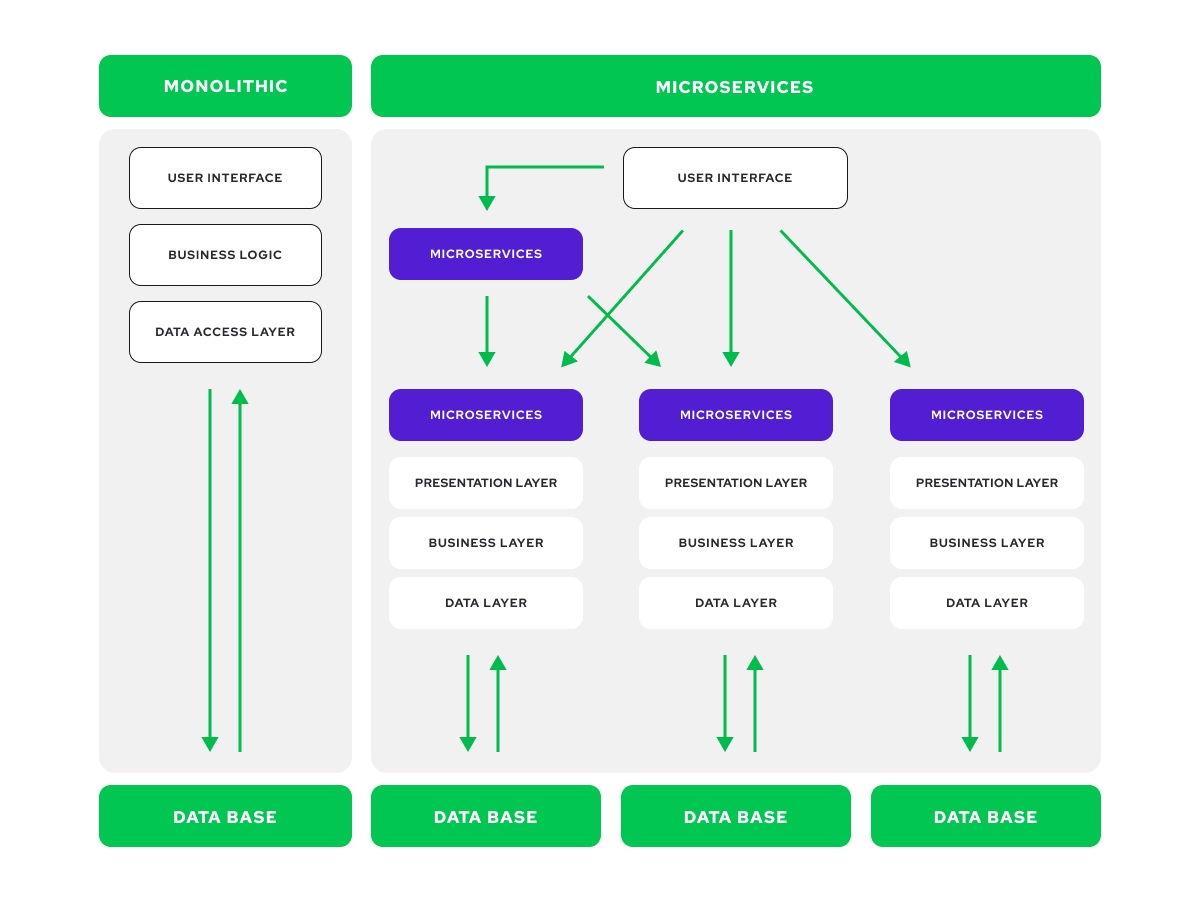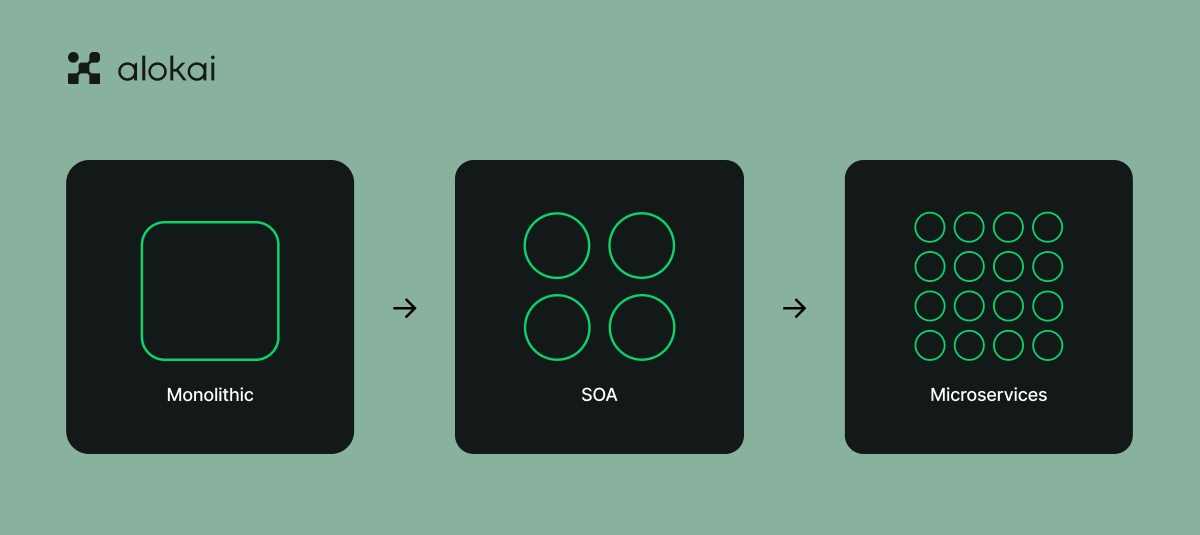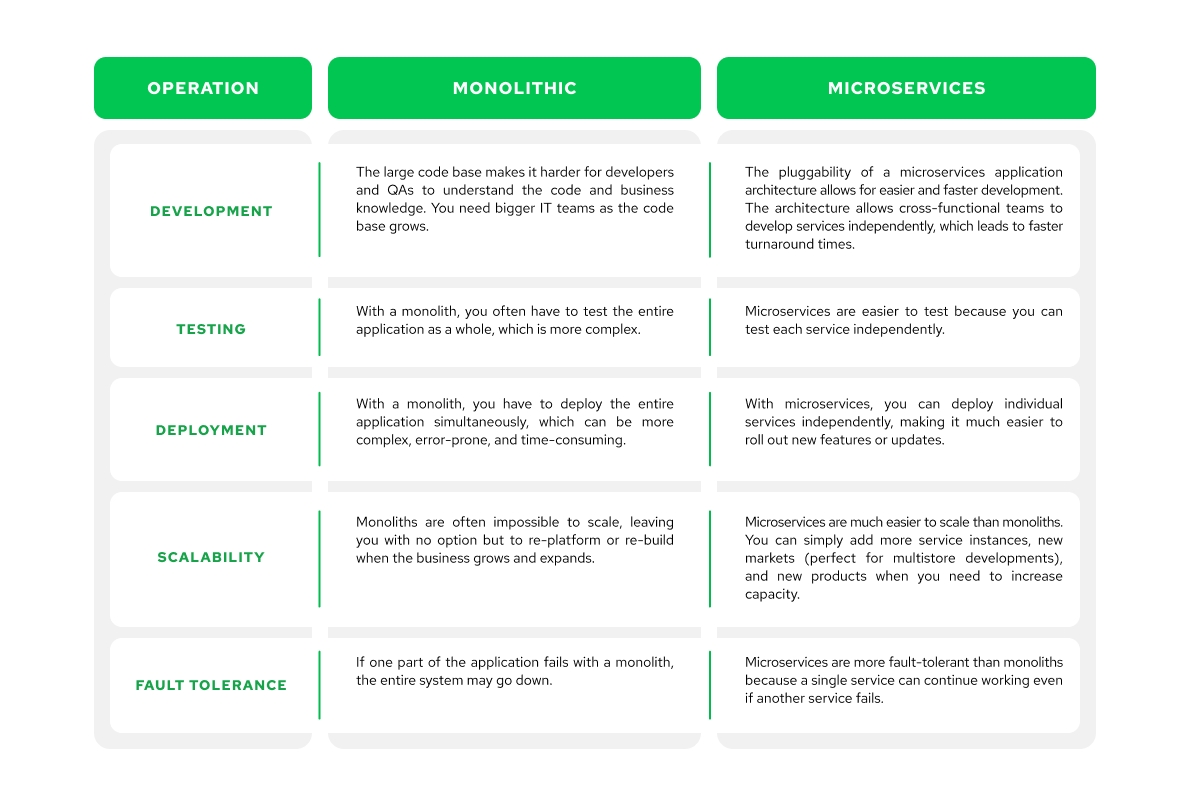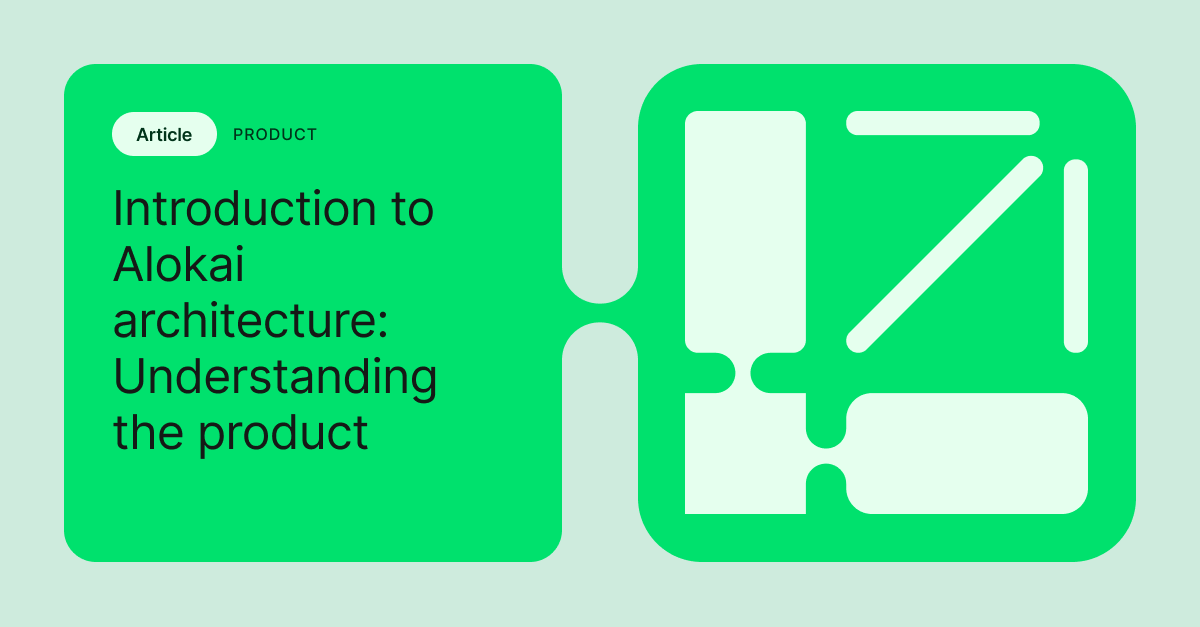Is your monolith holding you back? Transitioning to microservices could be your next step. This guide demystifies the process from monolith to microservice, designed to empower you with the knowledge to make informed decisions for your systems in 2024. Get insights on planning your transition, overcoming common challenges, and reaping the benefits of a microservice architecture.
Key takeaways
- Understanding the distinction between monolithic and microservices architectures is critical for successful migration. Monoliths are unified systems that become complex over time, while microservices consist of independently deployable services that communicate via APIs, offering enhanced scalability and agility.
- Transitioning to microservices requires careful consideration of business size and needs, with larger or rapidly scaling businesses benefiting more from the flexibility and independence of service management. Strategic decoupling during migration focuses on identifying service boundaries and prioritizing loosely coupled services.
- Technical considerations in microservices implementation include managing dedicated databases for service autonomy, ensuring reliable inter-service communication with appropriate patterns and tools, and employing the strangler pattern for a gradual, risk-mitigated transition from monolithic architecture.
Understanding monolith and microservice architectures
Understanding the architectures involved is the foundation of any successful migration. Monolithic and microservices architectures in software development represent two distinct paradigms, each with unique characteristics and advantages.

A monolithic architecture is a traditional approach where the entire application is built as a single, unified unit. This means all components, from the user interface to the backend systems, are interconnected and managed within a single codebase. Initially, this unified system simplifies development and deployment, making it easier to test and debug. However, as the application grows, it often becomes cumbersome and difficult to maintain.
In contrast, a microservices architecture breaks down an application into a collection of smaller, independent services, each focusing on a specific business capability. These services communicate with each other through APIs, allowing for greater flexibility and scalability. The transition from a monolithic system to microservices can bring significant benefits, such as reduced costs, enhanced security, and modern development practices like DevOps and containerization.
Monolithic architecture: The unified system
Monolithic architecture, with its unified system, has been the cornerstone of software development for many years. In a typical monolithic application, all the modules are tightly coupled, sharing the same backend codebase and underlying infrastructure. This approach offers simplicity in the early stages, as developers can work within a single codebase, simplifying end-to-end testing and debugging.
However, as the application evolves, this once straightforward system can become a tangled web of dependencies in multiple systems, including user interfaces. The accumulation of code over time leads to increased complexity, making it challenging to implement changes or updates. Even small modifications can require recompilation and extensive testing of the entire system, slowing down the development process and reducing the overall agility of the business.
Embracing microservices: Independent services communicating

Microservices architecture offers a modern solution to the limitations of monolithic systems. By breaking down an application into smaller, independent services, each with its own business logic and data storage mechanisms, microservices provide a modular approach to software development. These separate services communicate with each other through APIs, allowing for seamless integration and flexibility.
This modularity allows developers to manage and update services independently, including the remote user interface. For instance, in an eCommerce system, product listings, payment processing, and user authentication can be developed and deployed as separate projects, each optimized for its specific function. This independence enhances scalability and accelerates the time-to-market for new features and improvements.
Evaluating business scale and migration needs

Embarking on the journey from monolith to microservices necessitates an evaluation of your business’s scale and specific needs. Your organization’s size and complexity significantly influence whether a microservices architecture is appropriate. The monolithic approach might still be sufficient for smaller businesses with simpler applications. However, as your business grows, the limitations of monolithic systems become more apparent.
A microservices architecture can substantially benefit larger businesses with more intricate operations. This approach allows for:
Scalable and flexible service management
Ensuring that your systems can grow alongside your business without compromising performance or agility
An assessment of current and future needs is vital, particularly for eCommerce businesses that foresee rapid scaling and high transaction volumes.
When monolith meets its limits

Monolithic applications, while initially advantageous, often struggle to keep pace with growing business demands. As the application expands, the inherent complexity of the monolithic architecture can lead to significant challenges in scalability and flexibility. For example, Uber’s monolithic system hindered their ability to quickly launch new features and perform system updates, highlighting the scalability and agility issues associated with monoliths.
These challenges are exacerbated by the difficulties in updating and maintaining monolithic applications. Slow deployment cycles and the need to recompile and test the entire platform for even minor changes can severely impact the pace of business growth. Such limitations clarify when a monolithic system has reached its practical limits and a transition to microservices is necessary.
Scaling up with microservices
Microservices architecture offers a scalable solution to the limitations faced by monolithic applications. Each service can be independently scaled to meet demand by breaking down the application into smaller services. This targeted scalability is crucial for supporting a growing customer base, as it allows businesses to deploy more instances of specific services without the need to scale the entire application.
This approach enhances performance and leads to more efficient resource utilization and cost savings. Additionally, the ability to update and maintain services independently ensures that the system remains flexible and competitive without large-scale disruptions. The microservices migration strategy thus enables businesses to adapt quickly to changing market conditions and customer needs.
Decoupling services: A strategic approach
Decoupling services from a monolithic application is critical in transitioning to a microservices architecture. This process involves identifying service boundaries and prioritizing which services to migrate first. A strategic approach to decoupling can significantly reduce the risks and complexities associated with the migration.
Organizing microservices around business capabilities ensures that each service is designed with a specific function, promoting loose coupling and high cohesion. Businesses can create a more modular and maintainable system by focusing on natural domain boundaries. The following subsections will delve into identifying service boundaries and prioritizing services for migration.
Identifying service boundaries
A collective effort between developers and domain experts is necessary to identify service boundaries. To define these boundaries within a monolithic application, it’s necessary to:
- Establish a common language shared between both parties.
- Encapsulate modules with clearly defined responsibilities using bounded contexts.
- Refactor these modules into microservices.
Candidate modules for the transition include those with specific functionalities requiring technological distinction and those loosely coupled. Applying best practices such as automated service identification using AI and tools can optimize migration, ensuring a smoother transition to microservices.
Prioritizing services for migration
When prioritizing services for migration, a thorough analysis of cost versus benefits is required. Avoid refactoring everything simultaneously; concentrate on the monolith's loosely coupled modules. These initial candidates for conversion to microservices are typically edge services or those with specific resource needs that differ from the rest of the monolith.
Evaluating business criticality, test coverage, security posture, and organizational support helps determine the priority of migration services. Introducing an inter-process communication (IPC) adapter can facilitate the coexistence and interaction between microservices and monolithic modules during migration, ensuring a seamless transition.
Performance-driven development in microservices
Performance-driven development is vital when transitioning to a microservices architecture. Aligning microservices with performance metrics ensures the system meets business goals and improves user experience. This approach encourages forming smaller, focused teams that can operate more independently and quickly adapt to changes.
Out-of-the-box (OOTB) solutions offer the following benefits:
- Customization enabling businesses to fine-tune digital experiences and bolster performance
- Alignment with changing business needs
- Backward compatibility with previous application versions
- Enhanced agility
- Reduced costs
Aligning microservices with performance metrics
Aligning microservices with performance metrics is important to achieve business goals and enhance user experience. Effective performance monitoring in a microservices architecture requires meticulously tracking key performance indicators (KPIs). This approach focuses on decentralized service performance rather than traditional monolithic metrics, ensuring each service meets its specific objectives.
By implementing a robust monitoring strategy, businesses can achieve:
- More frequent and reliable software updates
- Quick adaptation to user requirements
- Alignment with performance metrics to enhance overall system efficiency
- Remaining competitive and responsive to market demands
- This ensures that the business remains competitive and responsive to market demands.
Offering customizable OOTB solutions
Customizable OOTB solutions enable businesses to offer tailored digital experiences and optimize performance. Microservices facilitate selecting best-in-class solutions that meet specific performance requirements, ensuring that each service is optimized for its intended function. This flexibility allows businesses to adapt quickly to changing market conditions and customer needs.
The transition to microservices offers various benefits, including cost reduction, enhanced agility, and strengthened security. By ensuring backward compatibility with previous application versions, businesses can maintain continuity and avoid disruptions during the migration process. This approach ensures that new features and functionalities can be introduced seamlessly, enhancing the overall user experience.
The strangler pattern: Facilitating gradual migration

The strangler pattern is an established strategy that aids in the gradual migration from a monolithic system to a microservices architecture. This pattern allows for incremental refactoring, enabling continuous integration and deployment without the need to overhaul the entire codebase at once. Instead, new microservices are developed alongside the existing monolith, gradually replacing its functionalities.
A facade acts as the interface layer in the strangler pattern, routing requests to the appropriate part of the application—either the existing monolith or the new microservices. This approach ensures that operational improvements are realized with each newly introduced microservice, providing immediate value to the business during the migration process.
Parallel testing is essential to ensure new microservices provide identical responses to the legacy system, affirming their readiness before fully transitioning. The gradual replacement approach mitigates the risk of bugs and minimizes potential downtime during the migration, ensuring a seamless and efficient transition.
Applying the strangler to legacy systems

Applying the strangler pattern to legacy systems involves a step-by-step modernization approach, reducing the risk of missing critical functionalities during the migration. The process includes moving legacy databases, business logic, and behaviors that support the application while configuring APIs to access old data from the monolith. This ensures that the legacy system continues functioning smoothly while new microservices are integrated.
An example of this approach is BestBuy.com, which leveraged the strangler pattern to manage holiday traffic peaks and support future processes. By gradually introducing microservices and validating their performance, BestBuy.com modernized its system without disrupting user experience. This case study highlights the effectiveness of the strangler pattern in managing complex migrations and ensuring a seamless transition to a microservices architecture.
Implementing microservices: Technical considerations
Several technical considerations are necessary for a smooth transition and optimal performance when implementing microservices. One key aspect is managing data objects in a distributed environment, where each microservice has its own dedicated database. This approach supports service autonomy but introduces challenges such as enforcing data relationships, handling data redundancy, and ensuring efficient data access. These challenges can be effectively addressed by focusing on only the essential data for each microservice.
Another critical consideration is ensuring reliable inter-service communication. Microservices architectures require robust communication mechanisms to handle requests between services, manage latency, and maintain data consistency. Businesses can ensure seamless interaction between services and maintain system integrity by employing patterns like Saga, API Composition, and CQRS.
Managing data in a distributed environment
Managing data in a distributed environment is a core aspect in a microservices architecture. Each service typically has its data storage mechanisms, supporting specific goals and ensuring service autonomy. However, this can lead to issues such as enforcing data relationships across services and data redundancy. To address these challenges, businesses must adopt data replication and consistency strategies, ensuring that all services have access to the necessary data without compromising performance. One common challenge is dealing with legacy data-related issues, which can arise when integrating older data storage mechanisms into a modern microservices architecture.
The Shared Database anti-pattern, where multiple services share a single database, can cause security problems and make it difficult to evolve the system architecture. Instead, businesses should focus on establishing dedicated data stores for each service and implementing robust data management practices. This approach ensures that services can operate independently while maintaining the integrity and consistency of the overall system.
Ensuring reliable inter-service communication
Reliable inter-service communication is vital for the success of a microservices architecture. This involves handling requests between services carefully, managing network latency, and employing sophisticated load-balancing techniques. Existing data interactions play a crucial role in ensuring seamless communication between microservices. Patterns like the Saga pattern can manage data consistency by using a series of compensating transactions. Similarly, API Composition simplifies client interactions by collating responses from various services.
Tools like Istio, a service mesh, can be employed to improve communication management and provide observability for inter-service interactions. By implementing these patterns and tools, businesses can ensure that their microservices communicate reliably and efficiently, maintaining the overall integrity and performance of the system.
Summary
Transitioning from a monolithic system to a microservices architecture is a complex but rewarding journey. By understanding the fundamental differences between these architectures, evaluating business needs, and strategically decoupling services, businesses can unlock new scalability, flexibility, and resilience levels. Performance-driven development and customizable OOTB solutions further enhance the benefits of microservices, ensuring that the system meets evolving business goals and user requirements.
The strangler pattern provides a practical approach to gradual migration, minimizing risks and disruptions while modernizing legacy systems. Businesses can ensure a smooth transition and maintain system integrity by focusing on technical considerations such as data management and inter-service communication. Embracing microservices is not just a technical upgrade; it’s a strategic move that prepares businesses for the future, enabling them to stay competitive and responsive in a rapidly changing market.













